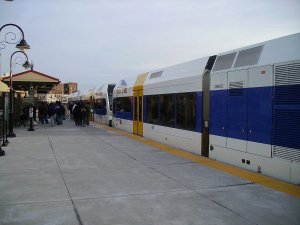
Camden is a regional transportation center for South Jersey with the Walter Rand Transportation Center, local and regional bus services, light rail, PATCO, and connections to regional rail. Photo ©Wikimedia Commons.
The beginning or end of a trip made by public transportation, “the first or last mile,” is typically the most time-consuming, most uncomfortable, and least reliable portion of a trip. University Transportation Center partners at Rowan University are creating an effective and specialized approach to the Last Mile Challenge for the City of Camden, NJ, to improve transportation accessibility, public health, education, and employment opportunities for Camden City residents.
Getting to and from a transit center can often be the most difficult part of a trip. Walking home or to your destination only works if it is nearby, shuttles might run on strict schedules, and taxis and ride-sharing apps can get expensive if you have to use them regularly.
These first and last-mile gaps are issues that many cities face, and can make it hard for people to connect with jobs, education, healthcare, and more if solutions are not implemented that expand the reach of public transportation to improve mobility and accessibility of vital services.
Dr. Mohammad Jalayer, an associate professor of civil and environmental engineering at Rowan University and an affiliated researcher at Rutgers Center for Advanced Infrastructure and Transportation (CAIT), is leading a project exploring first and last-mile challenges in underserved, New Jersey communities — specifically the City of Camden.
“Over the last decade, the City of Camden has seen an economic boom ranging from its downtown waterfront to neighborhoods throughout the city,” Dr. Jalayer said. “This economic undertaking has been supported by comprehensive efforts to rebuild the downtown street grid, underground utilities, and the streetscape to improve pedestrian, vehicle, and bicyclist movements. However, constraints continue to exist in connecting residents to new jobs coming to the City as well as other critical services.”
The project is a joint effort by Camden Community Partnership, in collaboration with Rowan University: Center for Research and Education in Advanced Transportation Engineering Systems (CREATEs), and the South Jersey Transportation Authority (SJTA).
Researchers will be exploring the first and last mile problems in the underserved Camden community, examining current transportation networks and assessing improvements needed to facilitate equitable, affordable, and implementable last-mile transportation options, and identifying best practices and lessons learned from other states to mitigate the last-mile problems in the area.
They will also be undertaking an extensive community and business outreach effort. Dr. Jalayer said that as part of this initiative, researchers are surveying city residents with an online questionnaire that they hope will provide a better understanding of what issues residents are facing in their daily trips and what services they need the most access to.
“Creating an effective and specialized approach to the last mile challenge for the City creates an opportunity to address transportation accessibility, public health, and education and employment opportunities for Camden City residents,” he said.

First and last mile gaps can impact how people travel and whether or not they have access to vital services such as jobs, healthcare, and education.
Potential users of first and last mile transportation services may have a variety of different needs. While some people will be commuting to work, others might be traveling for recreation. Additionally, some travelers might lack a personal vehicle and have no other option, while others might choose public transportation out of convenience. Dr. Jalayer explained that when implementing first and last mile solutions, it is important to meet the specific needs of the riders.
Successful first and last mile solutions can improve mobility, health, and access to transportation services for vulnerable communities, while also improving safety and decreasing vehicle usage in the area.
Dr. Jalayer said that after getting feedback from the community, researchers will begin exploring potential first and last mile solutions, including improving pedestrian facilities, transit station amenities, and partnerships with ride-sharing programs.
The goal is to develop a plan based on community feedback and consider potential solutions that would make the most sense for the City and its residents, he said. The team then hopes to implement this plan as part of a pilot project.
“The results from this project will provide recommendations to Camden City and stakeholders that make the transportation system in the downtown and neighborhoods accessible, safe, and equitable,” Dr. Jalayer said. “It will also provide a model that can be used to support cities and agencies across the state dealing with similar transportation barriers.”

